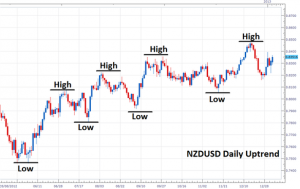Lesson 17 – Forex Trends, an overview
As we’ve mentioned a couple times in this course, consistency is what separates a profitable forex trader with an unprofitable one.
The consistency will come from your skill in accurately identifying trends then positioning your entry and exit points effectively, in accordance with that trend.
Remember, “Trend is a friend”.
Very tacky, but true.
What is a trend in forex markets?
First things first.
We need to define what a trend is before we can begin to identify one in the charts.
As a basic level, a trend is the general direction that the price is moving.
You’ll find three main trends in your tradin you should be able to identify.
- An uptrend (bullish)
- A downtrend (bearish)
- A sideways trend (flat)
There isn’t a set timeframe or consensus for how long a price needs to move in a certain direction before it is called a trend. However, the longer a trend remains constant, the more qualified and dependable it becomes.
How do you identify a trend in forex markets?
The easiest way to identify a trend is to simply load up a chart and watch the price action of your chosen currency pair.
Price action is best viewed with candlesticks. Theses candlesticks display historic price changes of the chosen currency pair and are then plotted on your chart.
This allows easy visualization of where the price has been and how it has been changing over time. This will often enable you to quickly assess what general direction the market has been moving over a given timeframe.
Now, for most of our trading, we will be looking to trade either uptrends or downtrends.
In some cases you may want to consider trading sideways markets, however these cases are rarer as there is far more risk to deal with due to the unpredictability of a sideways market.
It’s better to ride a clear directional trend and enter your positions with confidence that the trend will briefly continue in the direction it was going.
Let’s focus on both the uptrend and downtrend and go into more detail about how to find them.
Uptrends in forex markets
As you’ll have guessed, an uptrend describes the price action in the market when the overall direction is considered to be upwards.
Often, you can clearly see the price going up over a period of time. If its obvious, then you are clearly in an uptrend.
However, to fully define and qualify an uptrend, we like to be more detailed. Essentially, we have an uptrend when each peak in the price action should be higher than the previous one, likewise, the troughs should also be higher than the previous troughs.
Therefore, we look for “higher highs and higher lows”.
As you can see in the chart above, the peaks of each move

ment are higher than the previous one. And the lows are higher then each previous low.
This showes upwards momentum and that the price is being pushed higher and higher.
In general as a trader, with this information we want to go long on this trend to ride it out until it ends.
Downtrends in forex markets
The downtrends essentially are the opposite of uptrends. The downtrend is when the price action overall is heading downwards.
When you see the price clearly falling over a given period of time, you are most likely looking at a downtrend.
However, again we like to discipline this statement by qualifying each downtrend.
Here, in contract to the uptrend we look for:
“Lower highs and lower lows”

We are looking for price action that is always dropping below its previous low with its respective highs also weakening.
This means that the market is running out of demand and we may be hitting buyer exhaustion. The market is now bearish and will likely trend downward.
In general as a forex trader, our play here is to short the market and ride the momentum downwards.
